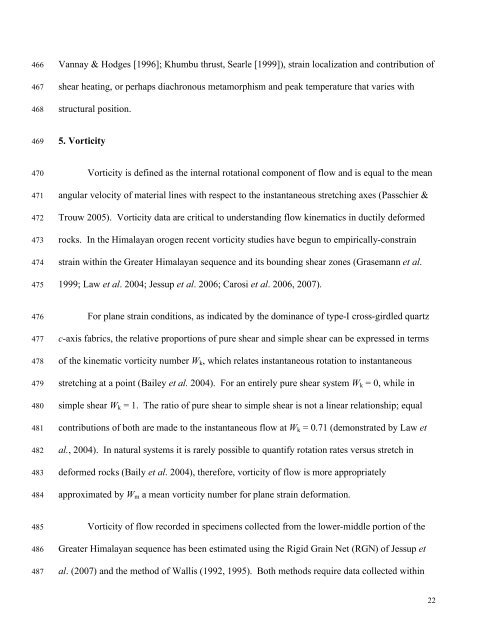Kinematics of the Greater Himalayan sequence, Dhaulagiri Himal ...
Kinematics of the Greater Himalayan sequence, Dhaulagiri Himal ...
Kinematics of the Greater Himalayan sequence, Dhaulagiri Himal ...
You also want an ePaper? Increase the reach of your titles
YUMPU automatically turns print PDFs into web optimized ePapers that Google loves.
466<br />
467<br />
468<br />
Vannay & Hodges [1996]; Khumbu thrust, Searle [1999]), strain localization and contribution <strong>of</strong><br />
shear heating, or perhaps diachronous metamorphism and peak temperature that varies with<br />
structural position.<br />
469<br />
5. Vorticity<br />
470<br />
471<br />
472<br />
473<br />
474<br />
475<br />
Vorticity is defined as <strong>the</strong> internal rotational component <strong>of</strong> flow and is equal to <strong>the</strong> mean<br />
angular velocity <strong>of</strong> material lines with respect to <strong>the</strong> instantaneous stretching axes (Passchier &<br />
Trouw 2005). Vorticity data are critical to understanding flow kinematics in ductily deformed<br />
rocks. In <strong>the</strong> <strong><strong>Himal</strong>ayan</strong> orogen recent vorticity studies have begun to empirically-constrain<br />
strain within <strong>the</strong> <strong>Greater</strong> <strong><strong>Himal</strong>ayan</strong> <strong>sequence</strong> and its bounding shear zones (Grasemann et al.<br />
1999; Law et al. 2004; Jessup et al. 2006; Carosi et al. 2006, 2007).<br />
476<br />
477<br />
478<br />
479<br />
480<br />
481<br />
482<br />
483<br />
484<br />
For plane strain conditions, as indicated by <strong>the</strong> dominance <strong>of</strong> type-I cross-girdled quartz<br />
c-axis fabrics, <strong>the</strong> relative proportions <strong>of</strong> pure shear and simple shear can be expressed in terms<br />
<strong>of</strong> <strong>the</strong> kinematic vorticity number W k , which relates instantaneous rotation to instantaneous<br />
stretching at a point (Bailey et al. 2004). For an entirely pure shear system W k = 0, while in<br />
simple shear W k = 1. The ratio <strong>of</strong> pure shear to simple shear is not a linear relationship; equal<br />
contributions <strong>of</strong> both are made to <strong>the</strong> instantaneous flow at W k = 0.71 (demonstrated by Law et<br />
al., 2004). In natural systems it is rarely possible to quantify rotation rates versus stretch in<br />
deformed rocks (Baily et al. 2004), <strong>the</strong>refore, vorticity <strong>of</strong> flow is more appropriately<br />
approximated by W m a mean vorticity number for plane strain deformation.<br />
485<br />
486<br />
487<br />
Vorticity <strong>of</strong> flow recorded in specimens collected from <strong>the</strong> lower-middle portion <strong>of</strong> <strong>the</strong><br />
<strong>Greater</strong> <strong><strong>Himal</strong>ayan</strong> <strong>sequence</strong> has been estimated using <strong>the</strong> Rigid Grain Net (RGN) <strong>of</strong> Jessup et<br />
al. (2007) and <strong>the</strong> method <strong>of</strong> Wallis (1992, 1995). Both methods require data collected within<br />
22

















